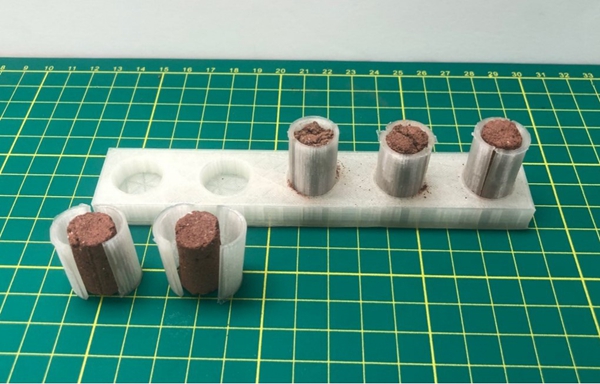Researchers at the University of Florida have successfully created 3D printed bricks that can be used to build the base of Camp Artemis Base made of lunar regolith and brine
Ever since the first space flight in the 1960s, humans have dreamed of not just visiting outer space planets, but inhabiting them. While living on the moon or Mars may seem like science fiction, it's actually something that some organizations are actively working on, and 3D printingcould be one of the keys to its success. And now, it may be one step closer to feasibility.

△ A concept habitat for a Martian outpost
Oct. 29, 2022 - Researchers at the University of Florida have successfully created 3D-printed bricks that could be used to build a base for Camp Artemis Base made of lunar regolith and salt water, according to Mohou.com.

This is certainly not the first effort to apply 3D printing to building housing in outer space. In fact, there are already a number of projects underway to try this. These include Redwire's tests on the International Space Station to determine if lunar regolith, or soil and rock deposits on the moon's surface, could be used to create habitats, NASA's current collaboration with AI Spaceworks to 3D print lunar habitats, and Washington State University's research into 3D printing on Mars. So far, however, it has been relatively hypothetical. This is one of the first projects to show that regolith tiles can withstand the extreme environments of outer space.

ΔLunar slabs made of loose rocks, dust and materials found on the lunar surface (Image credit: NASA)
3D-printed lunar tiles can withstand extreme environments
The 3D-printed lunar tiles project was led by researchers under Associate Professor Ranajay Goush of UCF's Department of Technology and Aerospace Engineering, and the results were presented in a paper entitled "Effect ofSintering Temperature on Microstructure and Mechanical Properties of MoldedMartian and Lunar Tile. Properties of Molded Martian and Lunar Regolith/Sintering Temperature on Microstructure and Mechanical Properties of Molded Martian and Lunar Regolith" was published in a recent issue of the International Journal of Ceramics. The lead author is research associate Peter Warren, but co-authors include Nandhini Raju, Hossein Ebrahimi, Milos Krsmanovic and aerospace engineering professors Seetha Raghavan and Jayanta Kapa. stone bricks to build a stationary Artemis base camp on the moon.

Link to related paper: https://www.sciencedirect.com/science/article/pii/S0272884222027560
To create the bricks, the team used adhesive jetting, whose binder is made from brine and exo-rock powder from UCF's Exo Rock Laboratory. Binder jetting is a perfect technique because it is uniquely suited for ceramic-like materials that are difficult to melt with lasers. ghous further noted that this gives it great potential for exo-rock-based fabrication. Although the initial raw parts were relatively weak, after baking at temperatures up to 1,200 degrees Celsius, the bricks were strong enough for their purpose.


△ Ranajay Ghosh, associate professor at UCF's School of Mechanical and Aerospace Engineering, and Peter Warren, graduate research assistant, demonstrate cylindrical bricks made using simulated lunar and Martian regolith and brine (Photo credit: UCF)
And the results are certainly promising. The researchers found that the resulting cylindrical bricks were able to withstand up to 250 million times the pressure of Earth's atmosphere. This suggests that binder jetting could be used in the future for the construction of materials and structures in space. Most importantly, it suggests that off-world structures will be able to be built using resources found in space. By opening up this path, future missions could reduce the valuable space and weight constraints associated with transporting construction materials, making habitation much more likely.
Ghosh concluded, "This research contributes to the ongoing debate in the space exploration community about finding a balance between in situ use of extraterrestrial resources and transporting materials from Earth. The more we further develop the technology to exploit the abundance of regolith, the more we will be able to establish and expand future base camps on the Moon, Mars and other planets."











